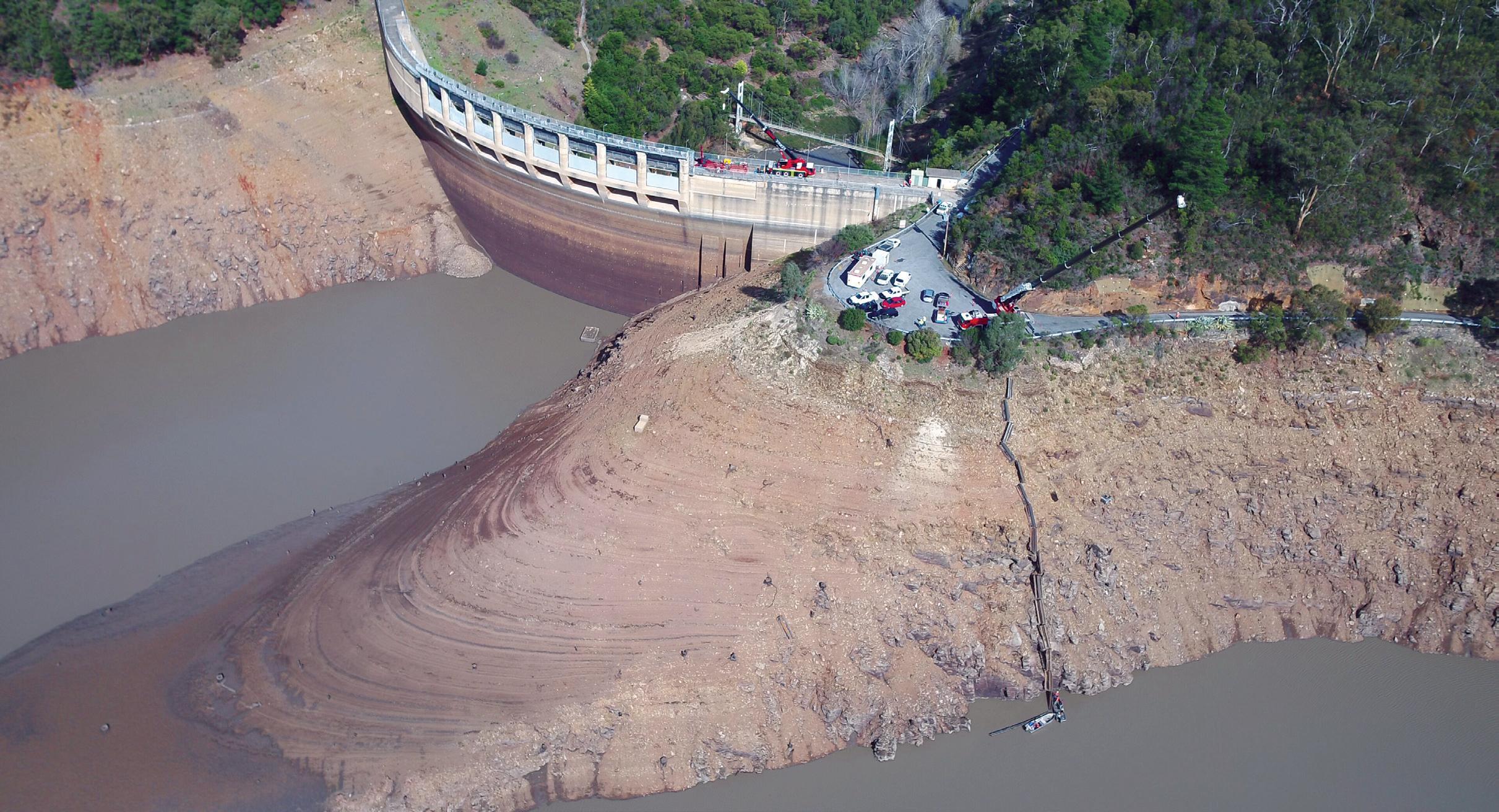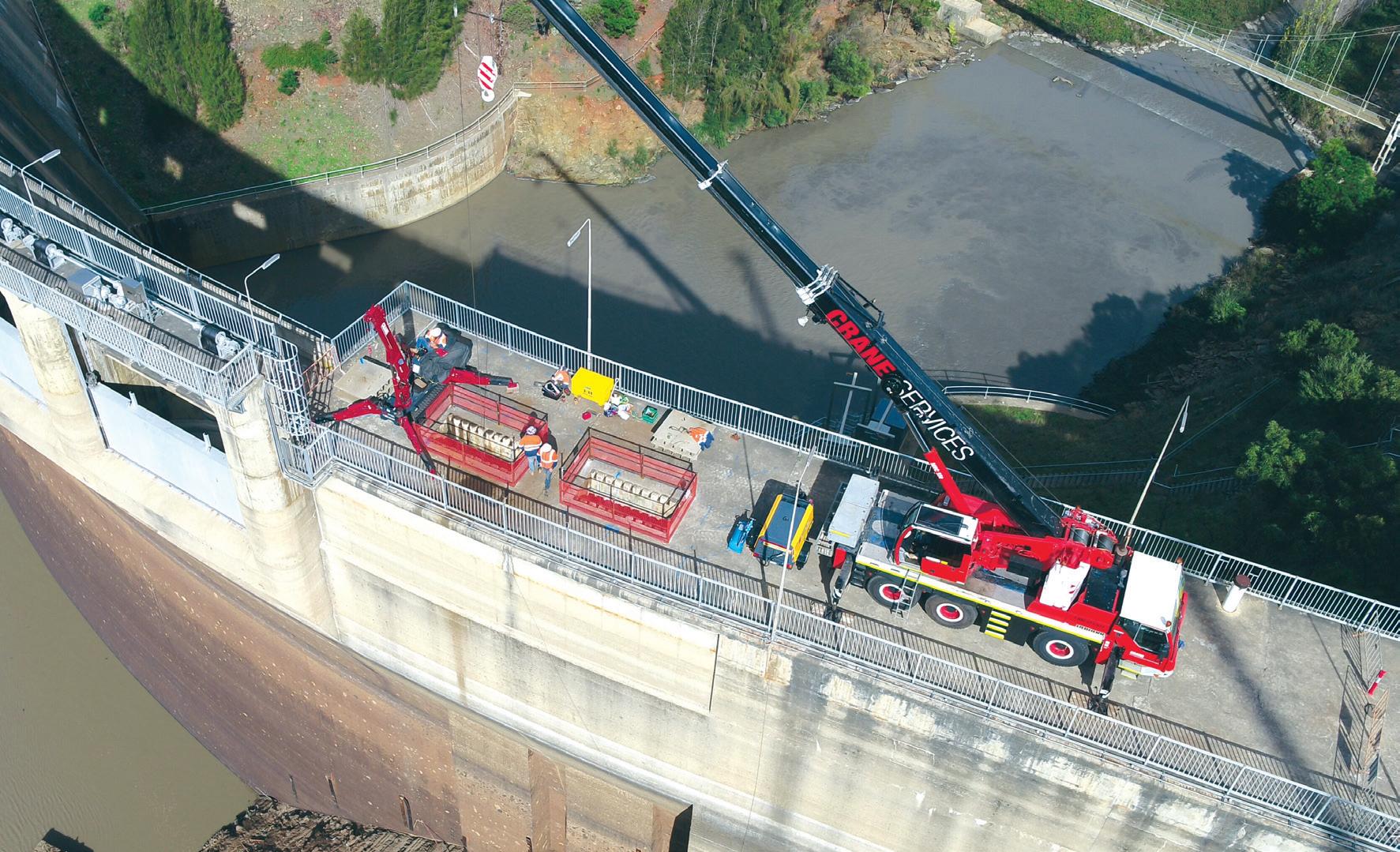
4 minute read
FEATURE - PROJECTS - Reservoir drained ahead of major safety upgrade
A MAJOR SAFETY UPGRADE IS EXPECTED TO COMMENCE AT MOUNT BOLD RESERVOIR IN 2022-23, SHOWN HERE AT HIGH WATER LEVEL.
Reservoir drained ahead of major safety upgrade
Mount Bold Reservoir was taken out of commission for four to five weeks recently for maintenance and condition assessment, requiring Adelaide’s largest water storage (46.4-gigalitre capacity) to be drained for the first time in 26 years. It was to prepare for a major safety upgrade expected to commence in 2022-23.
South Australian civil engineering and construction company Bardavcol was the main contractor, with GHD responsible for design. Planning for the early investigative works began in early 2020, and Bardavcol mobilised to site in early May. For the safety of the community and work crews, the Mount Bold Reservoir Reserve was temporarily closed to the public while these preparatory works were undertaken. On-site works were completed in early June, with the reserve reopened to the public at the June long weekend. The downtime was used to isolate the dam’s valves and pipework, refurbish the steel gate guides and bellmouth inlets, and carry out a detailed condition assessment of parts of the structure that would usually be underwater. To enable these works, the reservoir was emptied over a period of several weeks beginning in February when the water was around 14 gigalitres — or 30 per cent of capacity. While a small amount of water was still in the reservoir, a licensed commercial fisher removed fish, predominantly carp, which was either sent to the Sydney fish market or supplied for fertiliser. Just over 27 tonnes of carp were removed, along with 52 turtles. The turtles were rehomed in nearby bodies of water.
Mount Bold functions as a storage for both natural inflow and water directed from the River Murray. This stored water is diverted via the Onkaparinga River to the Happy Valley Reservoir where it’s then put through the nearby treatment plant before being supplied to a substantial part of metropolitan Adelaide — around 450,000 homes and businesses.

AN ALMOST EMPTY MOUNT BOLD RESERVOIR. THE BLACK PIPE-LIKE STRUCTURE IS A FLOATING DEBRIS BOOM USED TO PREVENT TREE BRANCHES OR LOGS FROMCLOGGING THE GATES DURING HIGH WATER EVENTS. IN THE FOREGROUND (RIGHT)IS A 100-TONNE CRANE USED TO LOWER FISHING BOATS INTO THE WATER AND TORETRIEVE FISH FROM THE RESERVOIR.
To ensure minimal wastage, water continued to be diverted to Happy Valley until Mount Bold was empty. Diversion of water from the River Murray to Mount Bold was also stopped during this time. With the storages at Happy Valley full, the treatment plant was then temporarily taken offline for planned essential maintenance, with the Adelaide Desalination Plant used to provide the majority of supply for customers who usually receive a combination of water from the desalination and Happy Valley facilities, fulfilling one of the operational purposes of the desalination plant. During the emptying of Mount Bold, water was also released from the reservoir into the Onkaparinga River, as part of licence obligations relating to the harvesting of water in the Western Mount Lofty Ranges. This helps to support the ecological function of the connecting watercourses, primarily below Clarendon Weir.
Around 30 megalitres a day (ML/day) was released in the months leading up to the reservoir emptying, increasing to 400 ML/day in late April and then reducing to between 7.5 and 30 ML/day in the weeks following. Oversight of this ongoing environmental flow program is led by Natural Resources Adelaide and Mount Lofty Ranges, and has been developed with the support of SA Water.
NO WATER WASTED
"The key point here is we haven't wasted any water from Mount Bold," said SA Water General Manager of Asset Operations and Delivery Mark Gobbie. "It’s only a four to five-week exercise and we start to fill the dam again from there. Otherwise we would have had to do that work underwater with divers, so this was a much safer — and probably more accurate way — of doing the work."
The bulk of the safety upgrade is expected to commence in 2022–23 subject to all relevant approvals and any technical constraints. The project is part of a $91 million SA Water investment plan which will also see the start of upgrades to dam structures at Baroota and Hindmarsh Valley. Similar works have recently been completed at Kangaroo Creek Reservoir, also carried out to align with Australian National Committee on Large Dams (ANCOLD) guidelines. SA Water raised and strengthened the dam wall and widened the spillway at a combined cost of $94 million. Taking nearly four years, the project included the rediscovery of a 1920s bridge and the removal of more than 27 tonnes of carp. The water level at Mount Bold was last lowered to near zero per cent of capacity in 1994, making this only the second time in the reservoir’s history that it has been emptied. Mr Gobbie commented: “The dam is 85 years old and still in very good condition. This is credit to the skills and expertise of the early engineers who designed it and the construction crews who built it.

A 60-TONNE CRANE ON THE DAM WALL, USED FOR LOWERING THE WORKBOX INTO THE TWO RECTANGULAR SHAFTS AND INSTALLING THE TWO BULKHEADS TO ISOLATE THEOUTLET PIPES.
“Following the completion of the equipment replacement and condition assessment in early June, some of metropolitan Adelaide’s normal supply from the River Murray resumed movement via the Murray Bridge to Onkaparinga pipeline, to assist winter rains in slowly refilling the reservoir.
“A timeframe for refilling is partly subject to rainfall. Our dam levels across the Mount Lofty Ranges catchments usually peak between late winter and spring each year, and we keep our storage reservoirs at a lower level, to provide room for the expected heavy rains during this time. “A lower water level at Mount Bold at the start of this year, following a dry 2019 winter, made mid-2020 an ideal time to carry out the preparatory and investigation works. Planning for proposed dam safety upgrades at Baroota and Hindmarsh Valley is still in the early stages. We expect to begin works at these sites within the next four years, as detailed in our regulatory proposal for 2020–24.”
Written by John Satterley
Images courtesy SA Water.

